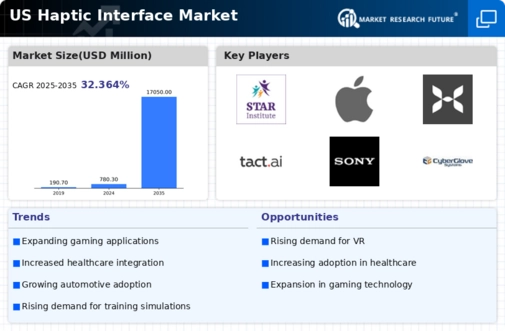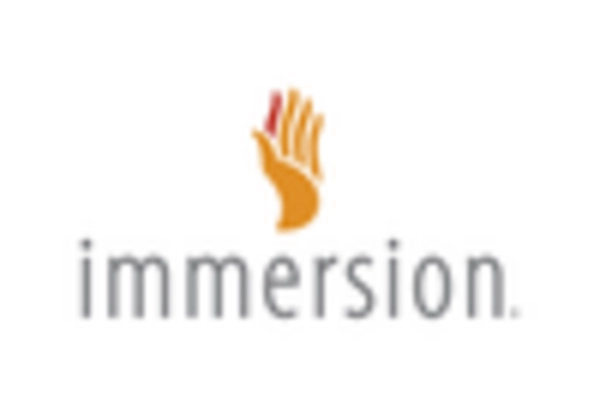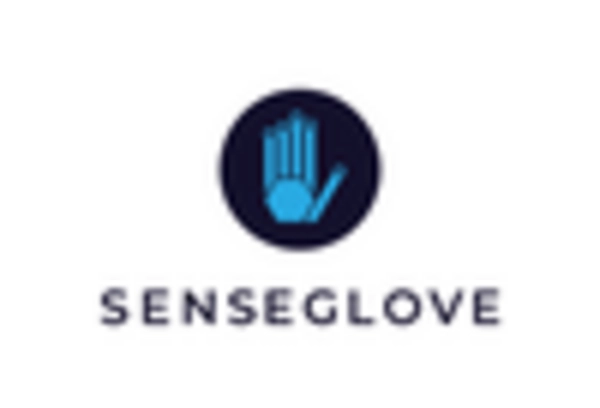Rising Demand for Immersive Experiences
Consumer preferences are shifting towards more immersive experiences, which is a key driver for the haptic interface market. Industries such as gaming, entertainment, and education are increasingly incorporating haptic technology to enhance user engagement. The demand for virtual reality (VR) and augmented reality (AR) applications is particularly notable, as users seek more interactive and tactile experiences. According to recent estimates, the market for VR and AR is expected to grow at a CAGR of over 30% through 2027. This trend suggests that as more applications emerge, the haptic interface market will likely expand, driven by the need for enhanced sensory feedback in various applications.
Expansion of Haptic Technology in Education
The integration of haptic technology in educational tools is emerging as a notable driver for the haptic interface market. Educational institutions are increasingly adopting haptic devices to facilitate interactive learning experiences, particularly in STEM fields. These tools allow students to engage with complex concepts through tactile feedback, enhancing comprehension and retention. The market for educational technology is projected to grow by over 20% annually, suggesting a robust demand for innovative learning solutions. As educational institutions recognize the benefits of haptic feedback, the haptic interface market is expected to see increased adoption, further diversifying its application landscape.
Growing Adoption in Robotics and Automation
The haptic interface market is witnessing growth due to the increasing adoption of haptic technology in robotics and automation. As industries seek to enhance precision and control in robotic applications, haptic feedback systems are becoming essential. These systems allow operators to receive tactile feedback, improving their ability to manipulate robotic devices effectively. The robotics market is anticipated to grow at a CAGR of around 25% over the next few years, indicating a strong demand for haptic solutions. This trend suggests that as automation continues to expand across various sectors, the haptic interface market will likely experience significant growth driven by the need for enhanced human-robot interaction.
Technological Advancements in Haptic Feedback
The haptic interface market is experiencing a surge due to rapid technological advancements in haptic feedback systems. Innovations in materials and sensor technologies are enhancing the realism and responsiveness of haptic devices. For instance, the integration of advanced actuators and microcontrollers is enabling more precise tactile sensations. This evolution is particularly evident in consumer electronics, where the demand for immersive experiences is growing. The market is projected to reach approximately $2 billion by 2026, reflecting a compound annual growth rate (CAGR) of around 15%. As these technologies continue to evolve, they are likely to drive further adoption across various sectors, including gaming and virtual reality, thereby significantly impacting the haptic interface market.
Increased Investment in Research and Development
Investment in research and development (R&D) is a significant driver of growth in the haptic interface market. Companies are allocating substantial resources to innovate and improve haptic technologies, aiming to create more sophisticated and versatile applications. This trend is particularly evident in sectors such as healthcare and automotive, where the potential for haptic feedback to improve user interaction is being explored. For example, R&D spending in the tech sector has seen an increase of approximately 10% annually, indicating a strong commitment to advancing haptic technologies. As these investments yield new products and applications, the haptic interface market is likely to benefit from enhanced functionality and broader adoption.
















Leave a Comment